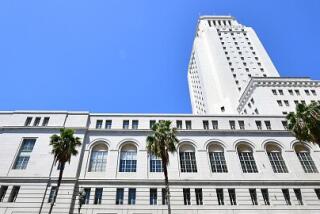Angeles Crest accident could’ve been prevented, angry officials and residents say

The double-decker car-hauling truck crawled up twisting Angeles Forest Highway, its driver choosing a rush-hour shortcut used by many commuting between the high desert’s Antelope Valley and the Los Angeles Basin.
Riding with another out-of-state co-driver, he passed a sign with a truck and a red line through it, prohibiting trucks of his vehicle’s weight, officials said. Cresting the range, which has peaks of nearly 8,000 feet, he wheeled the huge vehicle south onto Angeles Crest Highway.
By the time he reached La Cañada Flintridge around dusk, his brakes were failing, officials said. He picked up speed on the final straightaway and struck a car as he sailed over the 210 Freeway, dragging it southbound into a crowded intersection in a village business district. He plowed into five more vehicles and then a bookstore-coffee shop. When it was over, a 12-year-old girl and her father were dead, 12 people were injured and several were in the hospital.
As investigators tried Thursday to sort out the chain of events, many officials and residents said the horrific accident never should have happened. It is also bringing scrutiny to government efforts to ensure and enforce truck safety along mountain routes north of Los Angeles.
For decades, the final descent into La Cañada had a runaway-truck escape lane for just such emergencies.
But Caltrans, the state highway agency, closed it a decade ago and planted landscaping there, saying truck safety on the route had improved.
Amid a barrage of criticism and finger-pointing Thursday, the agency said it is now considering reopening the escape lane, as well as other safety measures. “This will be a top priority to get this done quickly,” said Doug Failing, director of Caltrans’ District 7.
Caltrans officials also plan to install safety signs but said the road is safe for trucks if driven properly.
Angry elected leaders wanted more: an immediate and complete ban on large trucks using the mountain route into the city.
“We do not need more study. We do not need more bureaucratic double talk,” La Cañada Flintridge Mayor Laura Olhasso said at a news conference. “We need to protect the people of our city. . . . Caltrans should immediately close Angeles Crest Highway to big rigs.”
Just seven months ago, a semi carrying 78,000 pounds of onions lost its brakes and plowed into cars in a parking lot near the same intersection. Weeks ago, city officials called on the state to prohibit trucks from using the route as a shortcut.
“This type of vehicle does not belong on that highway,” said Los Angeles County Supervisor Michael Antonovich, who represents the area. “That was a lethal weapon. The blindness of Sacramento has aided the tragic killing of two people.”
To avoid freeway bottlenecks, more commuters are using mountain roads like Angeles Crest. These roads have become popular with motorists driving from new housing tracts in the high desert to jobs in the L.A. Basin.
The dead were identified as Angel Jorge Posca, 58, and his daughter Angelina, both of Palmdale. Family members declined to speak to The Times on Thursday. But Posca’s son, John, told KLTA Channel 5 that his sister and father were returning home from the family business in Long Beach.
He said Angelina didn’t mind tagging along on the long drive to the business because it allowed her to spend time with her father. “She had a lot of talent, big personality. . . . She was the baby and we all spoiled her.”
The truck driver, 43-year-old Marcos Barbosa Costa of Massachusetts, was arrested on suspicion of grossly negligent vehicular manslaughter. Investigators were still trying to determine whom he worked for and where the truck was based.
Why Costa chose the Angeles Forest route wasn’t clear Thursday. Investigators said they don’t know if he used maps or a GPS device. Both were available in the truck. Costa could have taken freeways into the L.A. Basin, such as the 5 or the 14.
Why his brakes failed was also being investigated. “Brakes are always going to be affected if they’re constantly being used,” said L.A. County Sheriff’s Sgt. Mark Slater. “A steep incline will require someone to use them more regularly.”
For its part, Caltrans said banning trucks on Angeles Crest was not a simple process and required coordination with other agencies.
Assemblyman Anthony Portantino, a former mayor of La Cañada Flintridge, called on the California Highway Patrol to increase patrols and checkpoints on the mountain route Costa took. Big trucks are prohibited on a county stretch of that route, but not the state highway near the crash site.
A CHP spokesman said that in the past, heavy enforcement by specialized truck teams had not been justified because big-rig traffic was so light in the Angeles Forest area.
“This is a very, very rare incident,” said CHP Sgt. Mark Garrett, who worked the area for 12 years. “If you try to deploy your resources effectively, the last place you want to go is where there’s little commercial traffic.”
At the crash scene Thursday, investigators pulled the rig from Peter Wannier’s Flintridge Bookstore and Coffeehouse. He echoed the sentiment of many in the neighborhood: “What such a truck is doing on [that highway] is beyond me.”
andrew.blankstein
@latimes.com
Times staff writer Ruben Vives contributed to this report.
More to Read
Start your day right
Sign up for Essential California for news, features and recommendations from the L.A. Times and beyond in your inbox six days a week.
You may occasionally receive promotional content from the Los Angeles Times.






